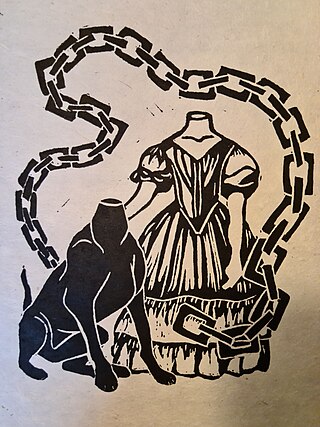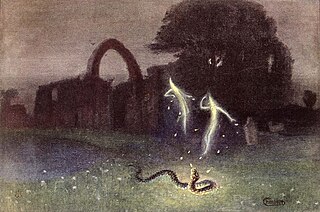Related Research Articles

A nursery rhyme is a traditional poem or song for children in Britain and other European countries, but usage of the term dates only from the late 18th/early 19th century. The term Mother Goose rhymes is interchangeable with nursery rhymes.
A proverb or an adage is a simple, traditional saying that expresses a perceived truth based on common sense or experience. Proverbs are often metaphorical and are an example of formulaic language. A proverbial phrase or a proverbial expression is a type of a conventional saying similar to proverbs and transmitted by oral tradition. The difference is that a proverb is a fixed expression, while a proverbial phrase permits alterations to fit the grammar of the context. Collectively, they form a genre of folklore.

A boggart is a supernatural being from English folklore. The dialectologist Elizabeth Wright described the boggart as 'a generic name for an apparition'; folklorist Simon Young defines it as 'any ambivalent or evil solitary supernatural spirit'. Halifax folklorist Kai Roberts states that boggart ‘might have been used to refer to anything from a hilltop hobgoblin to a household faerie, from a headless apparition to a proto-typical poltergeist’. As these wide definitions suggest boggarts are to be found both in and out of doors, as a household spirit, or a malevolent spirit defined by local geography, a genius loci inhabiting topographical features. The 1867 book Lancashire Folklore by Harland and Wilkinson, makes a distinction between "House boggarts" and other types. Typical descriptions show boggarts to be malevolent. It is said that the boggart crawls into people's beds at night and puts a clammy hand on their faces. Sometimes he strips the bedsheets off them. The household boggart may follow a family wherever they flee. One Lancashire source reports the belief that a boggart should never be named: if the boggart was given a name, it could neither be reasoned with nor persuaded, but would become uncontrollable and destructive.

In folklore, a will-o'-the-wisp, will-o'-wisp, or ignis fatuus, is an atmospheric ghost light seen by travellers at night, especially over bogs, swamps or marshes.

James Orchard Halliwell-Phillipps was an English writer, Shakespearean scholar, antiquarian, and a collector of English nursery rhymes and fairy tales.

English folklore consists of the myths and legends of England, including the region's mythical creatures, traditional recipes, urban legends, proverbs, superstitions, dance, balladry, and folktales that have been passed down through generations, reflecting the cultural heritage of the country. This body of folklore includes a diverse array of characters, such as heroic figures like Beowulf or Robin Hood, legendary kings like Arthur, and mythical creatures like the Green Man and Black Shuck. These tales and traditions have been shaped by the historical experiences of the English people, influenced by the various cultures that have settled in England over centuries, including Celtic, Roman, Anglo-Saxon, Norse, and Norman elements.
The word hobbit was used by J. R. R. Tolkien as the name of a race of small humanoids in his fantasy fiction, the first published being The Hobbit in 1937. The Oxford English Dictionary, which added an entry for the word in the 1970s, credits Tolkien with coining it. Since then, however, it has been noted that there is prior evidence of the word, in a 19th-century list of legendary creatures. In 1971, Tolkien stated that he remembered making up the word himself, admitting that there was nothing but his "nude parole" to support the claim that he was uninfluenced by such similar words as hobgoblin. His choice may have been affected on his own admission by the title of Sinclair Lewis's 1922 novel Babbitt. The Tolkien scholar Tom Shippey has pointed out several parallels, including comparisons in The Hobbit, with the word "rabbit".

The black dog is a supernatural, spectral, or demonic hellhound originating from English folklore, and also present in folklore throughout Europe and the Americas. It is usually unnaturally large with glowing red or yellow eyes, is often connected with the Devil, and is sometimes an omen of death. It is sometimes associated with electrical storms, and also with crossroads, barrows, places of execution and ancient pathways.

Punjabi folklore are a core part of the Punjabi culture. Other important components of Punjabi folklore are farces, anecdotes, idioms, folktales, and sayings.

"One for Sorrow" is a traditional children's nursery rhyme about magpies. According to an old superstition, the number of magpies seen tells if one will have bad or good luck.
Joseph Edwards Carpenter was an English playwright, composer, and songwriter.

A brownie or broonie (Scots), also known as a brùnaidh or gruagach, is a household spirit or hobgoblin from Scottish folklore that is said to come out at night while the owners of the house are asleep and perform various chores and farming tasks. The human owners of the house must leave a bowl of milk or cream or some other offering for the brownie, usually by the hearth. Brownies are described as easily offended and will leave their homes forever if they feel they have been insulted or in any way taken advantage of. Brownies are characteristically mischievous and are often said to punish or pull pranks on lazy servants. If angered, they are sometimes said to turn malicious, like boggarts.

The Boston Museum (1841–1903), also called the Boston Museum and Gallery of Fine Arts, was a theatre, wax museum, natural history museum, zoo, and art museum in 19th-century Boston, Massachusetts. Moses Kimball established the enterprise in 1841.
A Thrummy-cap is a character in Scottish folklore, that appears in many tales. It may have been invented by John Burness in his 1796 Thrummy Cap, A Legend of the Castle of Fiddes.
The Durham Proverbs is a collection of 46 medieval proverbs from various sources. They were written down as a collection, in the eleventh century, on some pages of a manuscript that were originally left blank. The manuscript is currently in the collection of Durham Cathedral, to which it was donated in the eighteenth century. The Proverbs form the first part of the manuscript. The second part, to which it is bound, is a copy of Ælfric's Grammar. Each proverb is written in both Latin and Old English, with the former preceding the latter. Olof Arngart's opinion is that the Proverbs were originally in Old English and translated to Latin, but this has since been disputed in a conference paper by T. A. Shippey.
A Dunnie is a small Brownie-like being in the folklore of the Anglo-Scottish borders, specifically Northumberland, the most famous being that of the Hazlerigg Dunnie of Hazlerigg in the parish of Chatton, Northumberland. The Dunnie has been known to take the form of a horse in order to trick a rider into mounting him before disappearing and leaving them in the muddiest part of the road. He also is said to disguise as plough-horses only to vanish when the ploughman takes him into the stalls.
Michael Aislabie Denham was an English merchant and collector of folklore.
James Hardy LL.D. was a Scottish naturalist and antiquarian. He was secretary of the Berwickshire Naturalists' Club from 1871 until at least 1896. At least two species have been named in his honour.
The Black Penny, also known as the Hume-byres Penny, was a coin with medicinal properties mentioned in the "Remedies for Hydrophobia", a short folkloric tale included in the Denham Tracts.
References
- ↑ James Hardy, ed., The Denham Tracts: A Collection of Folklore by Michael Aislabie Denham.. London: Folklore Society (1892).
- ↑ Drout, Michael D. C. (February 17, 2007). J.R.R. Tolkien Encyclopedia: Scholarship and Critical Assessment. Taylor & Francis. ISBN 978-0-415-96942-0 – via Google Books.
- ↑ "Reginald Scot's collection of magical texts". www.esotericarchives.com.
- ↑ "§7. "Gyre Carling". XI. The Middle Scots Anthologies: Anonymous Verse and Early Prose. Vol. 2. The End of the Middle Ages. The Cambridge History of English and American Literature: An Encyclopedia in Eighteen Volumes. 1907–21". www.bartleby.com. 25 June 2022.
- ↑ "The Fairy Mythology: Celts and Cymry: The Dance and Song of the Korred". www.sacred-texts.com.
- ↑ "Brewer, E. Cobham. Dictionary of Phrase & Fable. Thrummy Cap". www.bartleby.com.
- ↑ "Things That Go Bump in the Night". sites.pitt.edu.